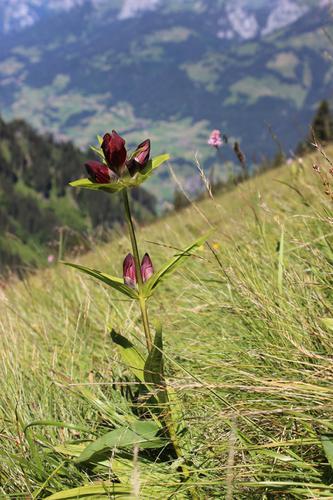当前位置:
X-MOL 学术
›
Appl. Veg. Sci.
›
论文详情
Our official English website, www.x-mol.net, welcomes your feedback! (Note: you will need to create a separate account there.)
Conservation and restoration of Nardus grasslands in the Swiss northern Alps
Applied Vegetation Science ( IF 2.8 ) Pub Date : 2019-11-27 , DOI: 10.1111/avsc.12462 Yasemin Kurtogullari 1 , Nora Simone Rieder 1 , Raphaël Arlettaz 1 , Jean‐Yves Humbert 1
Applied Vegetation Science ( IF 2.8 ) Pub Date : 2019-11-27 , DOI: 10.1111/avsc.12462 Yasemin Kurtogullari 1 , Nora Simone Rieder 1 , Raphaël Arlettaz 1 , Jean‐Yves Humbert 1
Affiliation

|
Aim: Species‐rich Nardus grasslands are high nature‐value habitats. In Switzerland, many of these grasslands are degraded even though they have been under protection since the 1980s. Degradation shows two divergent trends: Nardus grasslands are either dominated by Nardus stricta or by eutrophic plants, both trends leading to the disappearance of typical Nardus grassland species. With this study, we aim to identify the factors that could be adjusted to conserve the integrity of this habitat. Location: Bernese Alps, Switzerland. Methods: In 2016, we investigated the underlying causes of this degradation process by assessing vegetation composition in 48 Nardus grasslands located in the Swiss northern Alps of canton Bern and linking it to soil, management and environmental variables. To explore the effect of the degradation on higher trophic levels, orthopteran species richness and densities were assessed. Results: Results show that Nardus meadows (mown) are rarely degraded compared to Nardus pastures (grazed). Within pastures, eutrophic plants are most abundant on small pastures with low soil carbon/nitrogen ratio, indicating high nutrient availability. Nardus stricta dominance is most problematic on north‐exposed slopes and in summer pastures. A plausible driver of both degradation trends is the grazing management regime: within small pastures at low elevation where the grazing periods are short but intense, soil carbon/nitrogen ratio is low because of high dung deposition, thus the eutrophic species become dominant. Contrastingly, on large summer pastures with low‐intensity and long‐term grazing, N. stricta becomes dominant due to selective grazing. Both degradation trends show a negative impact on the orthopteran density. Conclusion: Species‐rich Nardus grasslands are a precious alpine habitat for specialised plant species and orthopterans. With an extensive mowing regime or a more controlled grazing regime that homogenises intensity in time and space, species‐rich Nardus grasslands can be conserved in Switzerland.
中文翻译:

瑞士北部阿尔卑斯山纳尔德斯草原的保护与恢复
目标:物种丰富的纳德斯草原是高自然价值的栖息地。在瑞士,尽管自 1980 年代以来一直受到保护,但其中许多草原已经退化。退化呈现出两种不同的趋势:Nardus 草原要么以Nardus stricta 为主,要么以富营养化植物为主,这两种趋势都导致典型的Nardus 草原物种消失。通过这项研究,我们旨在确定可以调整以保护该栖息地完整性的因素。地点:瑞士伯尔尼阿尔卑斯山。方法:2016 年,我们通过评估位于伯尔尼州瑞士北部阿尔卑斯山的 48 个纳尔德斯草原的植被组成并将其与土壤、管理和环境变量联系起来,调查了这种退化过程的根本原因。为了探索退化对更高营养水平的影响,评估了直翅目物种的丰富度和密度。结果:结果表明,与 Nardus 牧场(放牧)相比,Nardus 草甸(割下的)很少退化。在牧场内,富营养化植物在土壤碳氮比低的小型牧场上最为丰富,表明养分利用率高。Nardus stricta 优势在北露的斜坡和夏季牧场上最成问题。这两种退化趋势的一个可能的驱动因素是放牧管理制度:在低海拔的小牧场内,放牧时间短但强度大,由于粪便沉积量高,土壤碳/氮比低,因此富营养化物种成为主导。相比之下,在低强度和长期放牧的大型夏季牧场上,由于选择性放牧,N.stricta 成为主导。两种退化趋势都显示出对直翅目昆虫密度的负面影响。结论:物种丰富的纳尔杜斯草原是特殊植物物种和直翅目昆虫的宝贵高山栖息地。通过广泛的割草制度或更严格的控制放牧制度,在时间和空间上均质化强度,瑞士可以保护物种丰富的纳尔杜斯草原。
更新日期:2019-11-27
中文翻译:

瑞士北部阿尔卑斯山纳尔德斯草原的保护与恢复
目标:物种丰富的纳德斯草原是高自然价值的栖息地。在瑞士,尽管自 1980 年代以来一直受到保护,但其中许多草原已经退化。退化呈现出两种不同的趋势:Nardus 草原要么以Nardus stricta 为主,要么以富营养化植物为主,这两种趋势都导致典型的Nardus 草原物种消失。通过这项研究,我们旨在确定可以调整以保护该栖息地完整性的因素。地点:瑞士伯尔尼阿尔卑斯山。方法:2016 年,我们通过评估位于伯尔尼州瑞士北部阿尔卑斯山的 48 个纳尔德斯草原的植被组成并将其与土壤、管理和环境变量联系起来,调查了这种退化过程的根本原因。为了探索退化对更高营养水平的影响,评估了直翅目物种的丰富度和密度。结果:结果表明,与 Nardus 牧场(放牧)相比,Nardus 草甸(割下的)很少退化。在牧场内,富营养化植物在土壤碳氮比低的小型牧场上最为丰富,表明养分利用率高。Nardus stricta 优势在北露的斜坡和夏季牧场上最成问题。这两种退化趋势的一个可能的驱动因素是放牧管理制度:在低海拔的小牧场内,放牧时间短但强度大,由于粪便沉积量高,土壤碳/氮比低,因此富营养化物种成为主导。相比之下,在低强度和长期放牧的大型夏季牧场上,由于选择性放牧,N.stricta 成为主导。两种退化趋势都显示出对直翅目昆虫密度的负面影响。结论:物种丰富的纳尔杜斯草原是特殊植物物种和直翅目昆虫的宝贵高山栖息地。通过广泛的割草制度或更严格的控制放牧制度,在时间和空间上均质化强度,瑞士可以保护物种丰富的纳尔杜斯草原。



























 京公网安备 11010802027423号
京公网安备 11010802027423号